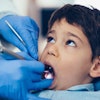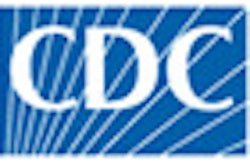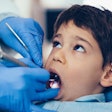
Oral health data collected last year in Minnesota show that the mouths of the state's third-graders meet and exceed some national norms but fall short on others, according to the Minnesota Department of Health (MDH).
This is the first time the state has collected random oral screening information. The findings were presented February 11 at the Minnesota Oral Health Summit in St. Paul. The summit also marked the release of the new Minnesota Oral Health Plan, another first for Minnesota.
"The data [from the screening] show mixed findings," Edward Ehlinger, commissioner of the MDH, said in a press release. "Oral disease is nearly 100% preventable, and this new information will help MDH determine what resources are needed and where best to place them to improve oral health statewide."
The percentage of screened third-graders in Minnesota whose teeth are protected by dental sealants is significantly higher than the national norm. Those screened also have fewer untreated cavities than both the national average and the U.S. Department of Health and Human Services' Healthy People target for 2010, according to the MDH's Oral Disease Prevention Unit's Third Grade Oral Health Basic Screening Survey.
However, survey data also reveal that the percentage of pupils screened who have a history of tooth decay (current fillings and untreated cavities) is higher than both the national average and the Healthy People 2010 target. The Healthy People initiative provides science-based, 10-year national objectives for promoting health and preventing disease.
"Sealant rates indicate that Minnesota schoolchildren receive preventive treatment, yet rates of untreated and previous tooth decay are on par with the rest of the nation," Merry Jo Thoele, RDH, MDH, dental director of the Oral Disease Prevention Unit, said in the release.
The comprehensive plan is a blueprint for reducing the prevalence of oral disease by focusing on access to care; prevention, education, and awareness; and workforce development, summit organizers noted.
More than 1,700 screened
For the MDH screening project, third-grade pupils received oral screenings at 40 randomly selected public schools with classroom sizes of 10 pupils or more. Screenings of 1,766 third-graders took place in 2010, between February and the end of May. It involved a standardized, cross-sectional, open-mouth survey developed by the Association of State and Territorial Dental Directors and conducted by trained contract and state health department staff and 31 volunteer dental hygienists. Data analysis lasted about six months. The dental survey was pretested in three pilot schools.
According to the MDH, an average of 64% of state third-graders screened have dental sealants on teeth, Thoele said. The national average is 23%, and the Healthy People 2010 target is 50%. While statistics also show that 18% of pupils screened have untreated tooth decay, this rate is better than both the national average of 29% and the Healthy People 2010 target of 21%. However, 55% of children screened have a history of cavities, which is slightly higher than the national average of 52% and exceeds the Healthy People 2010 target of 42%.
Data further show that race, ethnicity, and socioeconomic status are factors in oral health, Thoele said. Only 49% of Hispanic pupils have dental sealants, compared to 67% of non-Hispanic white pupils. While the prevalence of previous tooth decay is statistically insignificant between different populations, non-Hispanic white students generally have lower prevalence.
"The burden of oral disease in Minnesota is disproportionately borne by children from minority populations and schools with higher proportions of lower-income families," Thoele said.
Schools with higher proportions of pupils on or qualified for free or reduced-price lunch programs had increased rates of fillings and/or untreated tooth decay. In general, schools with 25% or less of students qualified for these lunch programs have better oral health than peers in schools with 75% or more qualified students.
"Results indicate that opportunities exist to strengthen disease prevention efforts and to put into motion strategies that lead to treatment access for specific populations," Thoele said. "Our new plan addresses this and other oral health issues by setting goals and providing specific, measurable, and time-phased objectives and activities for accomplishing them."



















